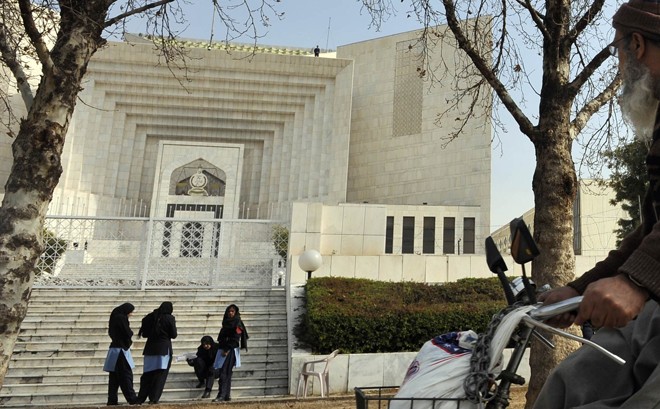

Truly told, the story of General (retd) Pervez Musharraf’s trial begins not in 2007, 2013, or 2014 but really in 1954.
In 1954, when the then Governor General of Pakistan, Mr. Ghulam Mohammad, dissolved the Constituent Assembly for having the audacity to attempt to pass a law requiring him to act only on the advice of his Ministers, little perhaps did anyone know that the legacy of that conflict in the Federal Court would have such a profound and long-lasting effect on the relationship between the institutions of the State.
The dissolved assembly approached the Sindh High Court and won. The Governor General, the commander-in-chief of the armed forces, and the incoming Council of Ministers challenged that verdict in the Federal Court.
An insight into what the bench felt about the Constituent Assembly, its authority, and the implications of the Court’s own decision on the matter at the time can be gleaned from the language used by the Court. In his judgment, Justice Munir wrote that the Constituent Assembly lived in a "fool’s paradise if it was ever seized with the notion that it was the sovereign body in the State", going on further to state that if the "result is disaster, it will merely be another instance of how thoughtlessly the Constituent Assembly proceeded with its business and by assuming for itself the position of an irremovable legislation to what straits it has brought the country". This is remarkable language coming from a court for the legislature.
Thus, in the Moulvi Tamizuddin case, as it came to be known, the Federal Court held that the Governor General’s dissolution of the assembly was valid and gave birth to what was known is the doctrine of necessity: "that which otherwise is not lawful is made lawful by necessity" and relied on the maxim that "the well-being of the people is the supreme law". This laid the intellectual foundation and legal argument, justifying every major extra-constitutional change of government that Pakistan was to see in the ensuing half a century.
The doctrine of necessity would go on to provide the basis for the legal cover to the military governments of Field Marshal Ayub Khan, General Yahya Khan, General Ziaul Haq and ultimately, the rule of General (retd) Pervez Musharraf in October 1999. In fact, each of these extra-constitutional governments were, in a manner of speaking, sanctified by the Supreme Court and, thus, cloaked with legitimacy through various decisions.
It is quite remarkable to think that barely fifteen years ago, in the Zafar Ali Shah case, the Supreme Court -- that included a judge who would go on to become perhaps the most celebrated Chief Justice in the modern history of Pakistan and the raison d’etre of the Lawyers’ Movement for the rule of law and removal of Musharraf -- validated the military coup of General Musharraf in 1999. The court explicitly recognised the "extra constitutional" nature of General Musharraf’s intervention but held that "a situation arose for which the Constitution provided no solution and the intervention by the armed forces through an extra constitutional measure became inevitable, which is hereby validated on the basis of the doctrine of State necessity".
In many ways, therefore, the story of armed intervention in Pakistan has also been the story of judicial decisions validating extra-constitutional regimes. Once the intellectual argument was accepted and the precedent was set, all that one needed to argue was that the situation met the established criteria. The supreme law was the well-being of the people, but their arbiters were not to be the people themselves.
And yet, within a decade, the judiciary of Pakistan would make a decisive and welcome break from this aspect of its past. It is interesting that in all previous attempts the armed forces had blamed the wilful neglect of the political class and the threat they posed to the existence of the state.
In November 2007, however, two things were different. This time, the people to blame for the existential threat to the country were not politicians but judges. Accused directly and also in sync with popular sentiment against an eight-year old Musharraf regime, the judges this time refused to buy the same arguments. On November 3, 2007, the Supreme Court released an order restraining any judges from taking oath under the PCO.
Then, following their restoration through a popular movement, in the Sindh High Court Bar Association case (or the judgment of 31st July as it is popularly known) the Supreme Court released a judgment breaking away from its past precedent and declaring that the doctrine of necessity cannot justify extra-constitutional measures and governance. It further declared the emergency of November 2007 as a violation of the Constitution and annulled all actions taken under it.
While there have been many criticisms of the post-restoration Supreme Court as being activist and too interfering in the domain of the Executive, at the same time the court has taken on the intelligence agencies and armed forces on the issue of the missing persons. Further, it heard and passed judgment on the Asghar Khan case in 2012.
There seems enough to suggest, therefore, that the days where the judiciary would serve as a legitimacy-granting device to intervention of the armed forces are past us. Furthermore, for all the criticism of judicial intervention over the last half a decade, it is clear that, at least rhetorically, the Supreme Court has tied itself firmly down into a corner stating time and again that only constitutional governance is acceptable in the country and that no extra-constitutional measures can be tolerated.
Musharraf’s trial, therefore, is a trial of the judiciary as much as it is of Musharraf. It flows directly out of a re-awakened consciousness in the judiciary about asserting the supremacy of the Constitution and it is the most crucial test thus far about the strength and conviction behind the espoused rhetoric that the Constitution must be held supreme at all costs in Pakistan.